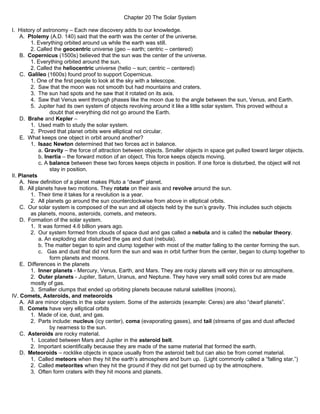
Solar System Chapter Explains History, Planets, Comets
- 1. Chapter 20 The Solar System I. History of astronomy – Each new discovery adds to our knowledge. A. Ptolemy (A.D. 140) said that the earth was the center of the universe. 1. Everything orbited around us while the earth was still. 2. Called the geocentric universe (geo – earth; centric – centered) B. Copernicus (1500s) believed that the sun was the center of the universe. 1. Everything orbited around the sun. 2. Called the heliocentric universe (helio – sun; centric – centered) C. Galileo (1600s) found proof to support Copernicus. 1. One of the first people to look at the sky with a telescope. 2. Saw that the moon was not smooth but had mountains and craters. 3. The sun had spots and he saw that it rotated on its axis. 4. Saw that Venus went through phases like the moon due to the angle between the sun, Venus, and Earth. 5. Jupiter had its own system of objects revolving around it like a little solar system. This proved without a doubt that everything did not go around the Earth. D. Brahe and Kepler – 1. Used math to study the solar system. 2. Proved that planet orbits were elliptical not circular. E. What keeps one object in orbit around another? 1. Isaac Newton determined that two forces act in balance. a. Gravity – the force of attraction between objects. Smaller objects in space get pulled toward larger objects. b. Inertia – the forward motion of an object. This force keeps objects moving. c. A balance between these two forces keeps objects in position. If one force is disturbed, the object will not stay in position. II. Planets A. New definition of a planet makes Pluto a “dwarf” planet. B. All planets have two motions. They rotate on their axis and revolve around the sun. 1. Their time it takes for a revolution is a year. 2. All planets go around the sun counterclockwise from above in elliptical orbits. C. Our solar system is composed of the sun and all objects held by the sun’s gravity. This includes such objects as planets, moons, asteroids, comets, and meteors. D. Formation of the solar system. 1. It was formed 4.6 billion years ago. 2. Our system formed from clouds of space dust and gas called a nebula and is called the nebular theory. a. An exploding star disturbed the gas and dust (nebula). b. The matter began to spin and clump together with most of the matter falling to the center forming the sun. c. Gas and dust that did not form the sun and was in orbit further from the center, began to clump together to form planets and moons. E. Differences in the planets 1. Inner planets - Mercury, Venus, Earth, and Mars. They are rocky planets will very thin or no atmosphere. 2. Outer planets - Jupiter, Saturn, Uranus, and Neptune. They have very small solid cores but are made mostly of gas. 3. Smaller clumps that ended up orbiting planets because natural satellites (moons). IV. Comets, Asteroids, and meteoroids A. All are minor objects in the solar system. Some of the asteroids (example: Ceres) are also “dwarf planets”. B. Comets have very elliptical orbits 1. Made of ice, dust, and gas. 2. Parts include: nucleus (icy center), coma (evaporating gases), and tail (streams of gas and dust affected by nearness to the sun. C. Asteroids are rocky material. 1. Located between Mars and Jupiter in the asteroid belt. 2. Important scientifically because they are made of the same material that formed the earth. D. Meteoroids – rocklike objects in space usually from the asteroid belt but can also be from comet material. 1. Called meteors when they hit the earth’s atmosphere and burn up. (Light commonly called a “falling star.”) 2. Called meteorites when they hit the ground if they did not get burned up by the atmosphere. 3. Often form craters with they hit moons and planets.